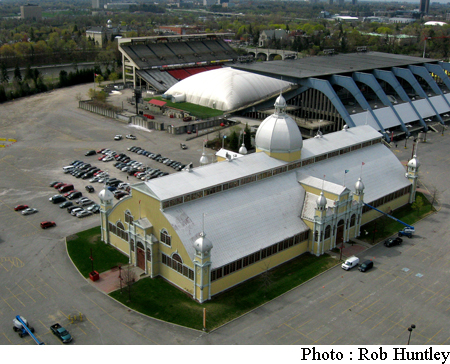
Ottawa - Lansdowne Park
Ottawa city council has voted to proceed with a controversial redevelopment plan for Lansdowne Park, a publicly owned urban park adjacent to the Rideau Canal UNESCO World Heritage Site in central Ottawa.
At issue are the unconventional sole-sourced procurement approach that effectively short-circuited the normal open and competitive process that a site of this complexity and history arguably warrants, and the transference of approximately 25 percent of the site to private developers for a mixed-use residential/commercial/retail complex that is incompatible with the history and heritage of the 142-year-old park.
The proposal leaves many important financial and urban planning questions unanswered, and puts the future of at least one of the park’s two designated heritage buildings at risk.

Why it matters
Lansdowne Park is a municipally-owned 37-acre public space in the heart of Canada’s capital, with a prime location next to the Rideau Canal UNESCO World Heritage Site. Arguably the most important publicly-owned open space in the central part of the city, it contains two designated heritage buildings—the Aberdeen Pavilion National Historic Site (1898) and the Horticulture Building (1914)—as well as an aging football stadium connected to a large arena/exhibition space (the Civic Centre).
Since 1868, Lansdowne Park has been host to major cultural, entertainment and sporting events. Residents and visitors alike attended provincial and national agricultural and industrial exhibitions there. The roster of events later expanded to include sporting and recreational activities—CFL football, OHL hockey, local soccer and curling—and social and cultural events ranging from craft sales and farmers markets to trade shows and rock concerts.
Why it’s endangered
Lansdowne Park has fallen into disrepair over the past few decades and is in need of revitalization.
In June 2010, city council voted to proceed with the unsolicited and controversial redevelopment plan in partnership with the Ottawa Sports & Entertainment Group (OSEG). This decision will see the transfer of approximately 25 percent of the public park space to OSEG for private development.
At issue is the introduction of some 300,000 square feet of mixed-use commercial/retail development and high-density residential buildings as tall as twelve storeys that are incompatible with the history and heritage of the 142-year-old park.
The proposed development will infringe on the protected view planes to the Aberdeen Pavilion NHS, as identified in its heritage conservation easement, and require the dismantling and relocation of the municipally designated Horticulture Building to make way for residential parking, despite one of its important heritage character-defining elements being its physical relationship to the adjacent Aberdeen Pavilion.
Where things stand
The Lansdowne Park redevelopment plan is highly controversial. Citizens, local organizations and elected officials have spoken out against the transfer of parts of the park for private commercial and retail development, and raised concerns about financial viability and potential impact on adjacent businesses. Every effort is being made by the local heritage group, Heritage Ottawa, to work with the city on behalf of Lansdowne Park’s heritage attributes, but the group has not been formally consulted. To date, cultural heritage impact statements, required by Provincial Policy Statement, have yet to be written for either designated heritage building.
Lansdowne Park was nominated by the Glebe Community Association
Top 10 Endangered Places
- Explore Past Listings
- National
- British Columbia
- Alberta
- Saskatchewan
- Manitoba
- Ontario
- Our Lady of Assumption Church
- 24 and 28 King Street East, Gore Park
- 24 and 28 King Street East, Gore Park
- Abell
- Alma
- Amherst Island, north-eastern shore of Lake Ontario
- Bala Falls
- Bata
- Davisville Junior Public School/ Spectrum Alternative Senior School
- Districts
- Former Grand Trunk Railways Locomotive Repair Shops
- Gibson Isolation Hospital
- Hamilton Education
- Joachim
- Kingston Collegiate Vocational Institute (KCVI)
- Lister
- Nor’Wester Mountain Range and Loch Lomond Watershed Reserve
- Nottawasaga Lighthouse
- Ontario - Views
- Ontario Place
- Ottawa - Lansdowne Park
- POW Camp 30/Boys Training School National Historic Site
- Petrie Building
- Port Dalhousie
- Somerset House
- The Black Horse Pub and Pig’s Ear Tavern
- Tivoli Theatre
- Views of Legislative Assembly of Ontario Building
- Ontario - Porter/McKinley Block
- Brighton Public School
- Cockshutt
- The Barber Paper Mill
- Bellevue House
- Central Experimental Farm
- Guild Inn
- David Dunlap Observatory and Park
- Riverdale Hospital
- The Old Grand Trunk Railway Station
- Quebec
- New Brunswick
- Nova Scotia
- Prince Edward Island
- Newfoundland and Labrador
- Territories
- Worst Losses Archive
- Nominate a Site
